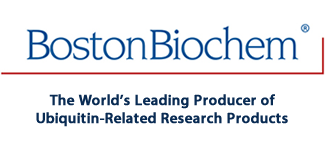
Recombinant Human Tetra-Ub WT Chains (K63-linked) Biotin, CF Summary
Product Datasheets
Carrier Free
CF stands for Carrier Free (CF). We typically add Bovine Serum Albumin (BSA) as a carrier protein to our recombinant proteins.Adding a carrier protein enhances protein stability, increases shelf-life, and allows the recombinant protein to be stored at a more dilute concentration.The carrier free version does not contain BSA.
In general, we advise purchasing the recombinant protein with BSA for use in cell or tissue culture, or as an ELISA standard.In contrast, the carrier free protein is recommended for applications, in which the presence of BSA could interfere.
UCB-310
| Formulation | Lyophilized from a solution in deionized water. |
| Reconstitution | Reconstitute at5 mg/mL in an aqueous solution. |
| Shipping | The product is shipped with dry ice or equivalent. Upon receipt, store it immediately at the temperature recommended below. |
| Stability & Storage: | Use a manual defrost freezer and avoid repeated freeze-thaw cycles.
|
Reconstitution Calculator
Background: Tetra-Ubiquitin
With a predicted molecular weight of 34 kDa, Tetra-Ubiquitin chains are composed of four Ubiquitin monomers that are covalently linked through isopeptide bonds, which typically form between a lysine residue of one Ubiquitin molecule and the C-terminal glycine residue of another Ubiquitin molecule (1). Each human Ubiquitin monomer is 76 amino acids (aa) in length and shares 96% and 100% aa identity with yeast and mouse Ubiquitin, respectively (2). Seven of the 76 aa in Ubiquitin are lysine residues that can participate in poly-Ubiquitin chain formation. Linkage through specific lysine residues is thought to serve as a signal that affects protein degradation, signaling, trafficking, and other cellular processes (3-8).
Linkage specific Tetra-Ubiquitin can also be used to investigate mechanism of binding and recognition by E1 or E2 enzymes, deubiquitinating enzymes, E3 ligases or other proteins that contain Ubiquitin-associated domains or Ubiquitin-interacting motifs (UIMs). This product is made with wild-type human recombinant Ubiquitin and linkage-specific enzymes. These chains are modified with biotin via primary amine coupling. This results in multiple biotinylated species modified at the N-terminus, as well as lysine residues. Biotinylated Ubiquitin can be detected using avidin-linked reagents.
- Scheffner, M. et al. (1995) Nature 373:81.
- Sharp, P.M. & W.-H. Li (1987) Trends Ecol. Evol. 2:328.
- Behrends, C. & J.W. Harper (2011) Nat. Struct. Mol. Biol. 18:520.
- Greene, W. et al. (2012) PLoS Pathog. 8:e1002703.
- Henry, A.G. et al. (2012) Dev. Cell 23:519.
- Tong, X. et al. (2012) J. Biol. Chem. 287:25280.
- Wei, W. et al. (2004) Nature 428:194.
- Zhang, J. et al. (2012) J. Biol. Chem. 287:28646.
Citation for Recombinant Human Tetra-Ub WT Chains (K63-linked) Biotin, CF
R&D Systems personnel manually curate a database that contains references using R&D Systems products.The data collected includes not only links to publications in PubMed,but also provides information about sample types, species, and experimental conditions.
1Citation: Showing 1 - 1
- Generation and Validation of Intracellular Ubiquitin Variant Inhibitors for USP7 and USP10Authors: W Zhang, MA Sartori, T Makhnevych, KE Federowicz, X Dong, L Liu, S Nim, A Dong, J Yang, Y Li, D Haddad, A Ernst, D Heerding, Y Tong, J Moffat, SS SidhuJ. Mol. Biol., 2017;0(0):.Applications: Bioassay
FAQs
No product specific FAQs exist for this product, however you may
View all Proteins and Enzyme FAQsRecombinant Enzymes
Recombinant Human His6-USP7 Protein, CF
Recombinant Human His6UBE2S Protein, CF
Recombinant Human Isopeptidase T/USP5 Protein, CF
Recombinant Human STAM-1 Protein, CF
Recombinant Human Ubiquitin Activating Enzyme (UBE1), CF
Recombinant Human His6-UBE2N/UBE2V2 Complex Protein, CF
Recombinant Human His6-UAF1 Protein, CF
Recombinant Human UCH-L3 Protein, CF
Recombinant Human UBE2K/E2-25K Protein, CF
Reconstitution Buffers
Reconstitution Buffer 1 (PBS)
Staining Reagents
Streptavidin-Alkaline Phosphatase
Streptavidin-Allophycocyanin
NorthernLights Streptavidin NL493
NorthernLights Streptavidin NL557
Avidin-Fluorescein
NorthernLights Streptavidin NL637
Streptavidin-Phycoerythrin
Supplemental Cell Selection Products
MagCellect Streptavidin Ferrofluid
Supplemental ELISA Products
Streptavidin-HRP
EvenCoat Streptavidin Coated Plates
EvenCoat Streptavidin Coated Plates, 5 Pack
Reviews for Recombinant Human Tetra-Ub WT Chains (K63-linked) Biotin, CF
There are currently no reviews for this product. Be the first toreview Recombinant Human Tetra-Ub WT Chains (K63-linked) Biotin, CF and earn rewards!
Have you used Recombinant Human Tetra-Ub WT Chains (K63-linked) Biotin, CF?
Submit a review and receive an Amazon gift card.
$25/€18/£15/$25CAN/¥75 Yuan/¥1250 Yen for a review with an image
$10/€7/£6/$10 CAD/¥70 Yuan/¥1110 Yen for a review without an image
ebiomall.com






>
>
>
>
>
>
>
>
>
>
>
植物材料 用最精确的方法,称取不超过100mg的植物材料,置于处理过的研钵,加入液氮进行研磨 将研磨得到的粉末,快速转移至无RNase,并经过液氮冷却的2mL离心管(自备),
但是,这样做的前提的,RNA提得要好,浓度要高,这样免得RNA降解到不能用了。因为在有二价阳离子的(DNAseI buffer含有)情况下,RNA在60度以上时必然发生非酶促降解。
想搞清一个问题,如何区别是因为small RNA 引起的调控呢?还是tRNA引起的调控,有没有有效的分离这两种RNA的办法呢?
样品处理:
a. 植物组织:取新鲜或-70℃冻存100mg组织在液氮中研磨,把粉末加入到1ml裂解液中混匀。
b. 动物组织:取新鲜或-70℃冻存100mg组织加1ml裂解液,用组织研磨杵或匀浆器匀浆处理。
c. 贴壁细胞:直接在培养板中加入裂解液裂解细胞,每106细胞加1ml 裂解液。用取样器吹打混匀。









